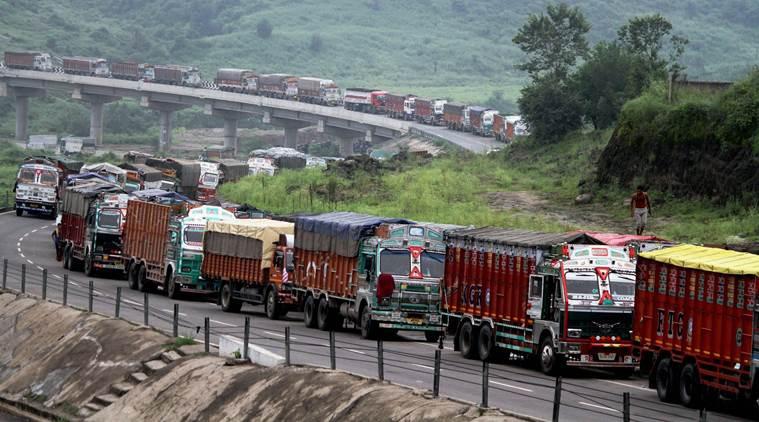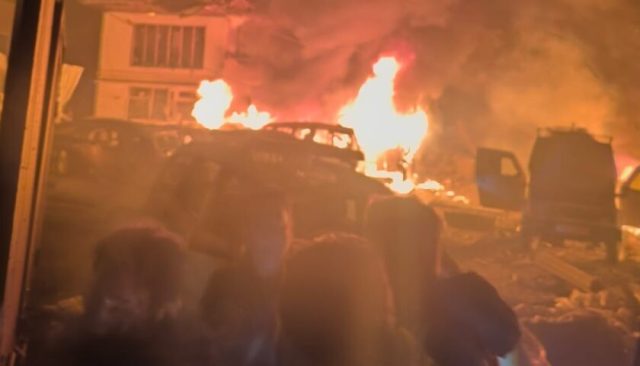Kashmir Crisis: NH-44 Blockage Triggers Mutton Shortage, Apple Losses & Inflation
By: Javid Amin| 14 September 2025
Kashmir is reeling under a crisis unlike any in recent memory. The closure of the Jammu–Srinagar National Highway (NH-44)—the region’s vital artery—has spiraled into a chain reaction of economic paralysis, cultural disruption, and social despair. What began as a natural calamity of landslides and torrential rain has now snowballed into a mutton shortage that has postponed over 150 weddings, fruit rotting in stranded trucks worth more than ₹400 crore, and inflation surging to levels that ordinary families can no longer bear.
For the Valley, where access to essentials depends almost entirely on a single supply line, the highway’s collapse is more than an infrastructural failure—it is a reminder of the fragile foundations on which Kashmir’s economy and daily life are built.
NH-44: Kashmir’s Fragile Lifeline Exposed
The 270-km Jammu–Srinagar National Highway, known as NH-44, is Kashmir’s only all-weather road link to the rest of India. Winding through treacherous mountain terrain, it connects the Valley’s seven million residents with supplies of food, fuel, medicine, livestock, and consumer goods.
But the latest closure—triggered by record rainfall on August 26–27, 2025—has crippled this artery. Landslides, subsidence, and flooding between Nashri and Udhampur have rendered multiple stretches impassable. At Thard and Balli Nallah, roadbeds were completely washed away. One tube of the Peerah tunnel remains blocked, while the Samroli area has been reduced to sludge.
Even with partial reopening under a one-way traffic system, movement is painfully slow. A journey that once took five hours now stretches beyond 18–20 hours, with trucks stranded for days. Loaders push vehicles manually through slippery mud patches, accidents multiply, and the absence of traffic regulation fuels chaos.
“Every closure feels like a siege,” said Fayaz Ahmad, a truck driver stranded near Ramban for 11 days. “We carry apples, sheep, even medicine. By the time we move, half the goods are gone. We sleep in the trucks, eat dry rotis, and wait for God.”
The National Highways Authority of India (NHAI) admits full restoration will take at least three months. Engineers are attempting to stabilize sinking stretches and rebuild washed-out roadbeds, but locals fear the monsoon and early snowfall could worsen the situation.
Mutton Crisis: Weddings on Hold, Traditions Broken
If there is one symbol of how deep the crisis runs, it is the mutton shortage. In Kashmir, mutton is not just food—it is the soul of celebration. No wedding feast is complete without Wazwan, the traditional 36-dish banquet dominated by lamb delicacies.
Yet the blockade has left the Valley starved of livestock. Over 400 sheep perished in stranded trucks—suffocated, starved, or drowned in slush. Truckers, unable to feed or water the animals, watched helplessly as entire consignments perished.
The ripple effect has been devastating:
-
150+ weddings postponed, as families refuse to hold ceremonies without mutton.
-
Local butchers shuttered shops, citing lack of supply.
-
Prices skyrocketed to ₹900–₹1,000 per kg, well beyond the reach of middle-class households.
-
Community feasts canceled, breaking cultural continuity.
At Anantnag, the Dar family had decorated their home for a September wedding. Invitations were sent, venues booked, gold jewelry bought. But with no mutton available, they had no choice but to postpone.
“We had everything ready—the guests, the decorations, the music. But without mutton, there is no wedding in Kashmir. My daughter is heartbroken,” said Mohammad Yousuf Dar, his voice cracking.
For butchers like Ghulam Nabi in Srinagar’s Bohri Kadal market, the crisis is existential. “We have no stock, no business. Customers come every morning, but we can only shrug. Our shops are lifeless,” he said, staring at empty hooks where carcasses once hung.
Fruit Crisis: Rotten Apples, Economic Blow
Parallel to the mutton shortage is the fruit growers’ nightmare. Kashmir’s **horticulture industry—worth over ₹10,000 crore annually—**is the backbone of rural livelihoods. Apples, pears, and plums from Kashmir feed markets across India, transported largely by NH-44.
But with trucks stranded for over 16 days, the losses are staggering:
-
₹400 crore worth of fruit rotting in trucks and godowns.
-
Sopore Mandi, Asia’s second-largest fruit market, paralyzed.
-
Farmers watching helplessly as entire harvests turn to waste.
“Each apple is our blood and sweat,” said Bashir Ahmad Bhat, a grower from Shopian. “We borrowed money for pesticides and packaging. Now the apples rot, and the loans remain. Who will repay them?”
The crisis has also revealed the vulnerability of relying solely on road transport. Growers are demanding:
-
Rail-based alternatives for perishable goods.
-
Cold storage facilities near mandis.
-
Compensation packages for losses.
Without urgent intervention, experts warn of farmer distress escalating into suicides.
Inflation and Market Chaos
As NH-44 remains crippled, inflation in Kashmir has spiraled. With goods unable to move freely:
-
Vegetable prices doubled in two weeks.
-
Poultry costs surged 40%.
-
Fuel shortages pushed transport fares up by 60%.
-
Medicines are either unavailable or sold at black-market rates.
The situation worsened after the 2023 deregulation of price controls, which left consumer protection bodies toothless. With no monitoring, profiteering has gone unchecked.
Daily wage earners and middle-income families are the worst hit. A rickshaw puller in Srinagar said he now spends more on a kilo of tomatoes than what he earns in an hour. Mothers cut back on milk, fathers skip meals, children cry for meat that isn’t there.
“Inflation is like a silent thief,” said Dr. Sameer Kaul, an economist at Kashmir University. “It erodes dignity, one plate at a time.”
Public Sentiment: “A Road Shuts, A Valley Suffers”
Anger simmers across the Valley. Social media is flooded with images of dead sheep in trucks, apples turning black, and weddings without feasts.
“This isn’t just about mutton or apples. It’s about our lives,” tweeted @KashmiriVoice, a local activist. “A road shuts, and a valley suffers. Why do we remain so vulnerable?”
Civil society groups have staged protests outside Sopore Mandi and Lal Chowk, demanding immediate relief. Many argue that Kashmir’s overdependence on NH-44 is a policy failure decades in the making.
Why Kashmir Remains Vulnerable
Experts say the crisis exposes three structural weaknesses:
-
Overdependence on NH-44 – With Mughal Road and Srinagar–Leh Highway seasonal and unreliable, Kashmir has no true alternative.
-
Poor infrastructure planning – Decades of reactive patchwork repairs instead of long-term geological stabilization.
-
Policy inertia – Failure to build cold chains, rail freight corridors, or regulate essential commodities.
Comparisons with Himachal Pradesh and Uttarakhand are stark. Both states face landslides, yet have diversified road and rail connectivity, reducing dependence on one highway.
Government Response
The J&K administration has announced:
-
₹100 crore relief package for fruit growers.
-
Plans to airlift essential medicines.
-
Talks with railways for temporary freight corridors.
But critics call the response too little, too late. “Relief after rot is not relief—it’s eyewash,” said Haji Abdul Rahman, president of the Sopore Fruit Growers Association.
The Road Ahead: Solutions & Lessons
Experts suggest a multi-pronged roadmap:
-
Infrastructure Resilience – Permanent stabilization of Ramban–Banihal stretch, new tunnels, and landslide-resistant design.
-
Alternative Connectivity – Year-round development of Mughal Road, accelerated completion of Udhampur–Baramulla rail line.
-
Cold Storage & Logistics – Mandis with cold chains, rail freight for perishables, modern packaging.
-
Price Regulation – Reinstating consumer protection mechanisms to check profiteering.
-
Disaster Preparedness – Early-warning systems for landslides, relief camps for stranded truckers.
Bottom-Line
The collapse of NH-44 is not just a transport bottleneck. It is a mirror held up to Kashmir’s vulnerabilities—economic, cultural, and structural.
When weddings are postponed for lack of mutton, when farmers cry over rotting apples, when inflation empties plates, the issue is no longer just a “road problem.” It is about dignity, survival, and the right to live without being held hostage to a single highway.
Unless policymakers treat this as a wake-up call, Kashmir will continue to lurch from one blockade to another—each more painful than the last.
As one weary truck driver near Ramban put it:
“The road decides our fate. And when the road dies, we die with it.”




